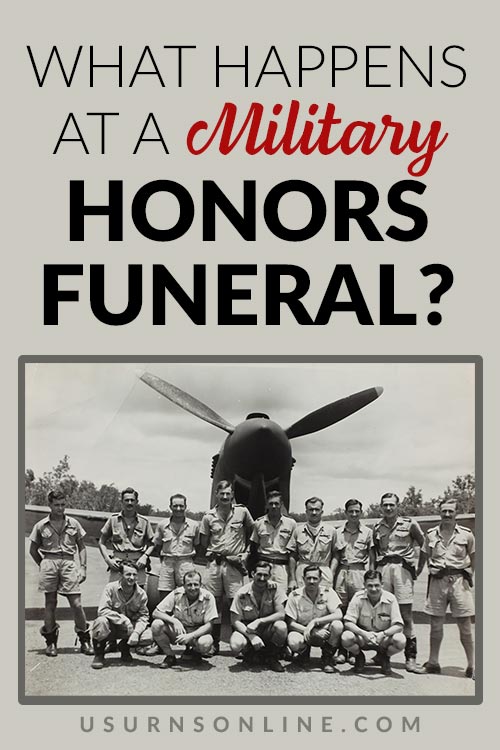Nothing is as stirring as a military funeral. It is a very patriotic and moving experience.
What is going to happen? Will there be a 21 gun salute? Will a rendition of Taps be played?
What is the difference between standard military funeral honors and full honors? If you don’t know what to expect, read on to find out.
But we’ll warn you – reading about a Military Honors Funeral and experiencing it are two very different feelings!
What is a Military Honors Funeral?
A veteran earns a Military Honors Funeral through honorable service to their country. The United States Armed Forces conducts this unique ceremony.
It is an honor conveyed by all branches of the military. The branches include Army, Airforce, Navy, Marines, and Coast Guard. Whether the service member died in battle or lived a long life, they are an honored veteran!
Every honorably discharged veteran is eligible for standard military honors. Not every honorably discharged veteran is eligible for full honors. More on that later.
Here’s What Happens at a Military Honors Funeral
First, let’s talk about what happens at a military honors funeral. There are two types: standard and full.
Standard Military Honors
Standard military honors are for our enlisted men and women.
These honors consist of:
Urns Made in the USA
A military chaplain presiding over the service
The military chaplain will officiate the funeral service and serve as counselor and pastor to the bereaved family. He will provide support and comfort as well as spiritual guidance. The chaplain will be able to re-enforce the scripture and the promise of eternal life. By reassuring the family that they will be reunited with their loved one, the chaplain fulfills his duties.
The military chaplain will offer his support before and after the funeral service.
Draping a United States flag over the casket
Draping the casket with the United States flag – the blue field of stars is at the casket’s head over the decedent’s left shoulder.
The flag will take the place of a traditional funeral pall.
An honor guard paying respects
The honor guard will present arms and salute the deceased. At the appropriate time, two members of the guard will perform the flag folding ceremony. The guard will fold the flag into a tri-corner shape. The guard will present the flag to the next of kin.
Upon presenting the flag to the next of kin, the presenter will say: “On behalf of the President of the United States, (the United States Army; the Marine Corps; the Navy; the Air Force or the Coast Guard), and a grateful nation, please accept this flag as a symbol of our appreciation for your loved one’s honorable and faithful service.”
The playing of Taps
The bugle call played at a military funeral is Taps, also called “Butterfield’s Lullaby.” It is easily one of the most recognizable melodies in the USA.
Here it is, performed by The United States Army Band:
The funeral ceremony ends with the playing of Taps. Everyone should stand and face the flag. Military personnel will salute, and civilians will place their right hand over their hearts.
Full Military Honors
Full Military Honors include all standard honors in addition to the following:
- Star-ranking officers are honored with a fired salute.
- Five-Star ranking Generals, along with chiefs of staff, cabinet members, and other high-ranking US officials will receive a 19-gun salute.
- Four-Star ranking General officers and flag officers will receive a 17-gun salute.
- Three-Star ranking officers will receive a 15-gun salute.
- Two-Star ranking officers will receive a 13-gun salute.
- One-Star ranking officers will receive an 11-gun salute.
- The 21-gun salute is reserved for the President as Commander-in-Chief (current, former, or elect)
- A military band and an escort platoon will participate. The size of the platoon will vary, depending on the rank of the officer.
- A Colonel/Captain and above will receive standard military honors and a caparisoned1, riderless horse. This horse symbolizes a fallen leader. The caparisoned horse will follow the limbers2 and caissons3.
(1) A caparison is a cloth covering laid over a horse for decoration.
(2) A limber consists of a two-wheeled cart designed to support an artillery piece such as a canon.
(3) A caisson is a two-wheeled cart. The cart carries artillery ammunition.
Armed Forces Military Funerals
The Armed Forces Military Funeral is reserved for those who exercised command over multiple branches of the United States Armed Forces.
The President of the United States (as Commander-in-Chief), the Secretary of Defense, the Chairman of the Joints Chief of Staff, and any officers granted multiple-service command will receive this honor.
An Armed Forces funeral includes:
- 19 or 21-gun salute. Those who served as President of the United States receive full honors plus a 21-gun salute. All other high-ranking officials receive a 19-gun salute with full honors.
- Escort guards from the armed forces. All five branches of the US military will be represented by an escort platoon.
Funerals for Military Spouses
When the spouse of a current or former member of the United States Armed Forces is being buried, the military will provide a casket team (pall-bearers) and a chaplain. The spouse would not receive any other military honors unless they served in the military.
Military Funeral Etiquette
Just like any funeral, there is a certain etiquette to follow. A military funeral deserves the same decency and standards. It is imperative to be respectful of the deceased and the family. Honoring your loved one is the essential part of this service.
What to Wear
Men should put on a dark suit and tie. Women should wear a dark dress, suit, or skirt and a blouse. Military personnel should wear their “Dress Uniform.”
Women should wear an appropriate-length dress or skirt. Ladies should display no cleavage at a funeral.
For further information, see our guide on What to Wear to a Funeral.
Where to Sit
Immediate family members will sit in the very front row. The family has the place of honor and can receive the folded flag more easily.
Everyone seated should stay seated throughout the entire service, unless directed to stand.
Should You Salute?
For all attendees who are not in uniform, only former military members may salute. Civilians should not salute. As a sign of respect, civilians should remove any headgear and place it over their hearts.
Military Funeral Honors Eligibility
The Armed Forces members that are eligible for honors are:
- Fighting men and women who have died in active duty.
- Veterans who served in active duty with an honorable discharge.
- Spouses of veterans.
Make sure to ask your funeral director to request all honors that are due to your loved one. They have earned it and deserve it. May God bless our servicemen and women!
Read next: VA Burial Benefits: How to make sure the military funeral expenses are paid
Pin It





